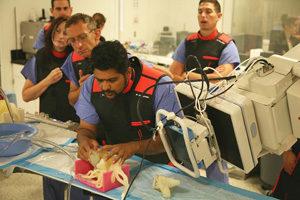Stratasys Helps Jacobs Institute Physicians Train and Prepare Treatment with 3D Printed Vascular Models
 It’s been about 27 years since the industry-leading 3D printing manufacturer Stratasys began their disruptive march on the global manufacturing front, and have become a household name in the areas of fashion, education, art and, perhaps most prominently, the medical industry. At the end of last year, Stratasys introduced their new Medical Solutions Group, which was built to help meet the growing demand for medically-driven 3D printed models, prototypes, and devices. Since then, Stratasys has shown even more skin-in-the-game in regard to new medical developments, having recently partnered with the Buffalo, New York-based Jacobs Institute to form the Center of Excellence, which will serve as a collaborative hub for developing and testing new prototypes and medical devices.
It’s been about 27 years since the industry-leading 3D printing manufacturer Stratasys began their disruptive march on the global manufacturing front, and have become a household name in the areas of fashion, education, art and, perhaps most prominently, the medical industry. At the end of last year, Stratasys introduced their new Medical Solutions Group, which was built to help meet the growing demand for medically-driven 3D printed models, prototypes, and devices. Since then, Stratasys has shown even more skin-in-the-game in regard to new medical developments, having recently partnered with the Buffalo, New York-based Jacobs Institute to form the Center of Excellence, which will serve as a collaborative hub for developing and testing new prototypes and medical devices.
Since announcing the Center of Excellence less than a month ago, the Stratasys-sponsored research center has already proved to offer immense value to the medical industry. Working together with the University at Buffalo’s Clinical and Translational Research Center (CTRC) and Kaleida Health’s Vascular Institute, physicians stationed at the Jacobs Institute have began working with Stratasys’ PolyJet 3D printing technology to develop treatment plans for endangering vascular issues, which include life-threatening health issues such as aneurysms, stroke, and blood clots.

Dr. Iyer evaluates a 3D printed patient-specific heart model during a surgery dry run prior to treating the patient.
Using CT and MRI scan data, physicians have been able 3D print patient-specific models, which has enabled them to generate sound treatment plans prior to the operation, and also to show the patient exactly how the treatment will be performed. Patient-specific 3D printed models allow the Jacobs Institute team to test out potential operational theories, and can also help inform physicians on potential complications before the patient is under time constraints while on the operating table.
“3D printing is valuable in planning complex procedures with a team. Without it, we prepare for complications on a theoretical basis,” said Dr. Vijay Iyer, an interventional cardiologist. “Many times, despite the best theoretical planning, we are faced with circumstances where we don’t know what to do.”
Stratasys has also provided medical researchers at the Jacobs Institute’s Center of Excellence with a newfound and efficient method for surgical training. Thanks to the 3D printed vascular models, rare conditions that were once deemed “untrainable” can now be physically examined, allotting physicians the opportunity to develop surgical skills within a no-risk environment. Not only are these vascular models more readily accessible and cost-effective than the traditional—and slightly medieval—method of training on human or animal cadavers, they also mimic the live feeling of tissues in a much more realistic fashion.
“3D vascular models represent a new paradigm for training the next generation of doctors. This paradigm includes surgical and endovascular simulation and skills evaluation before they are allowed to treat patients,” said Dr. L. Nelson Hopkins, the founder of the Jacobs Institute and the Gates Vascular Institute.
 With these patient-specific anatomical models, researchers from the Jacobs Institute are also able to accelerate and enhance the design of various medical devices. Using 3D printed vascular models, physicians are able to obtain feedback on device performance, which helps prevent unnecessary costs and harm to animal testing subjects. Recently, the researchers were able to test the adequacy of a device engineered to safely reach the brain. In order to do this, the Jacobs Institute utilized Stratasys’ PolyJet 3D printing solutions to create a series of models with varying levels of tortuosity, each of which were tested with the device. This practice would be near-impossible and potentially harmful to perform on animal subjects or patients, but with 3D printing technology, the entire process suddenly becomes much more streamlined and convenient.
With these patient-specific anatomical models, researchers from the Jacobs Institute are also able to accelerate and enhance the design of various medical devices. Using 3D printed vascular models, physicians are able to obtain feedback on device performance, which helps prevent unnecessary costs and harm to animal testing subjects. Recently, the researchers were able to test the adequacy of a device engineered to safely reach the brain. In order to do this, the Jacobs Institute utilized Stratasys’ PolyJet 3D printing solutions to create a series of models with varying levels of tortuosity, each of which were tested with the device. This practice would be near-impossible and potentially harmful to perform on animal subjects or patients, but with 3D printing technology, the entire process suddenly becomes much more streamlined and convenient.
Lastly, the partnership with Stratasys has enabled the Jacobs Institute researchers to perform all experimentation and training in-house, effectively eliminating costly and time-consuming reliance on external machine shops to produce their medical components. As the Jacobs Institute continues working closely with the 3D printing pioneering company Stratasys, as well as other Buffalo-based medical institutions, the Center of Excellence is primed to become one of the most innovative healthcare training and research hubs in the United States, effectively building upon Stratasys’ long-held involvement within the medical industry. Discuss how quickly they are making progress in the 3D Printed Vascular Models at Jacobs Institute forum over at 3DPB.com.
[Source: Stratasys]Subscribe to Our Email Newsletter
Stay up-to-date on all the latest news from the 3D printing industry and receive information and offers from third party vendors.
You May Also Like
IperionX Inks 10-Year Deal with Wisconsin Manufacturer for 80 Metric Tons of Titanium Per Year
IperionX, the Charlotte-based supplier of sustainable titanium powders used for additive manufacturing (AM) and metal injection molding (MIM), has signed a ten-year deal with United Stars, a group of industrial...
Gastronology Launches Industrial Production of 3D Printed Food for Dysphagia Patients
Food 3D printing has, in many ways, been an additive manufacturing (AM) segment looking for the right business case. While some applications are beautiful and others may or may not...
Lockheed Martin Leads $3M Investment in Q5D’s Electronics 3D Printing System
Q5D, an original equipment manufacturer (OEM) of robotic arm, hybrid additive manufacturing (AM) systems used for wire harness production, has closed a $3 million investment round. The investment arm of...
3D Printing News Briefs, April 6, 2024: Depowdering, Cybertruck Door Handles, & More
In today’s 3D Printing News Briefs, ioTech’s digital manufacturing CLAD technology is opening up opportunities for microelectronics and additive manufacturing. Hexagon and Raytheon Technologies commercially released the Simufact Additive Process...
































